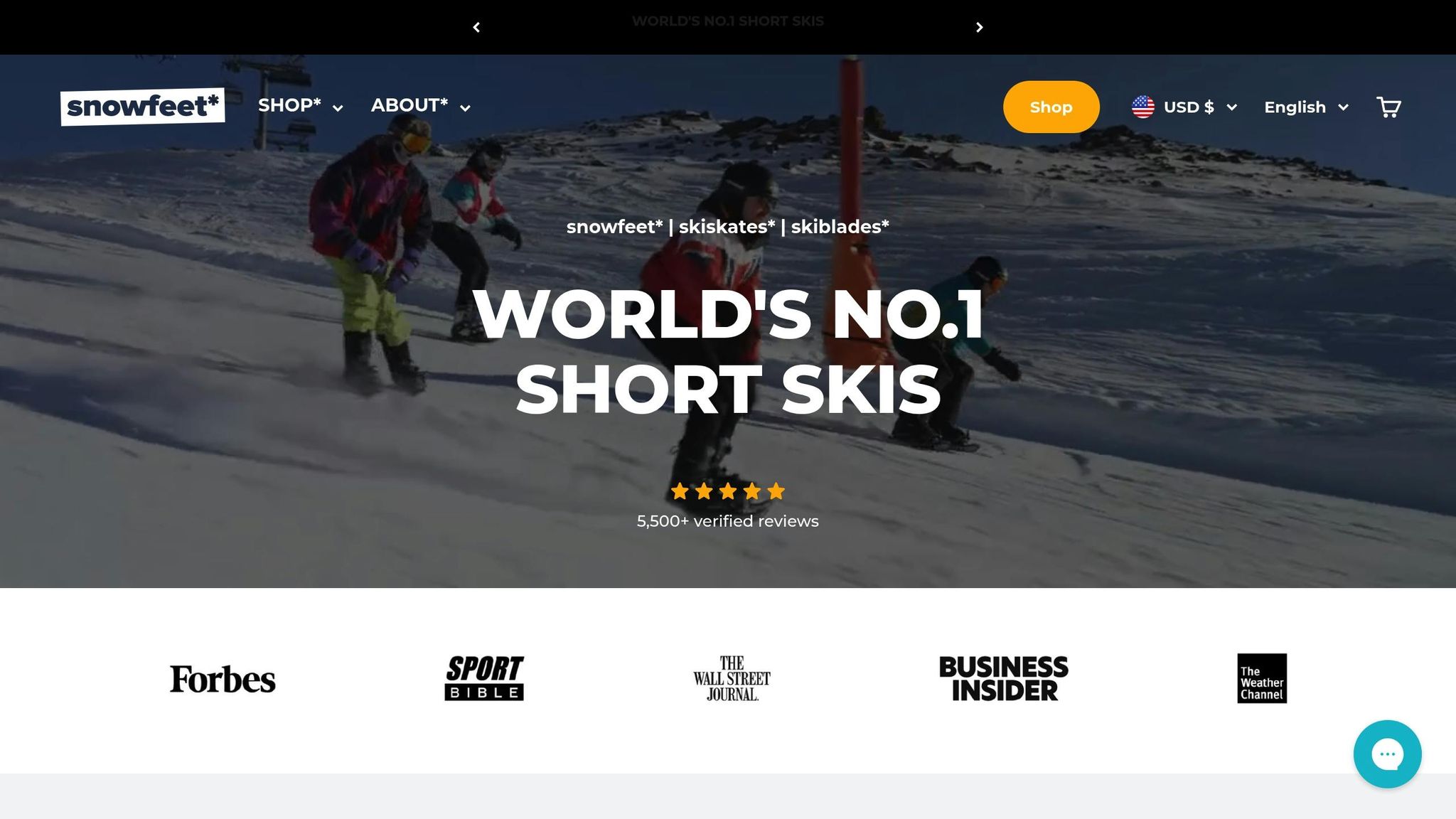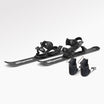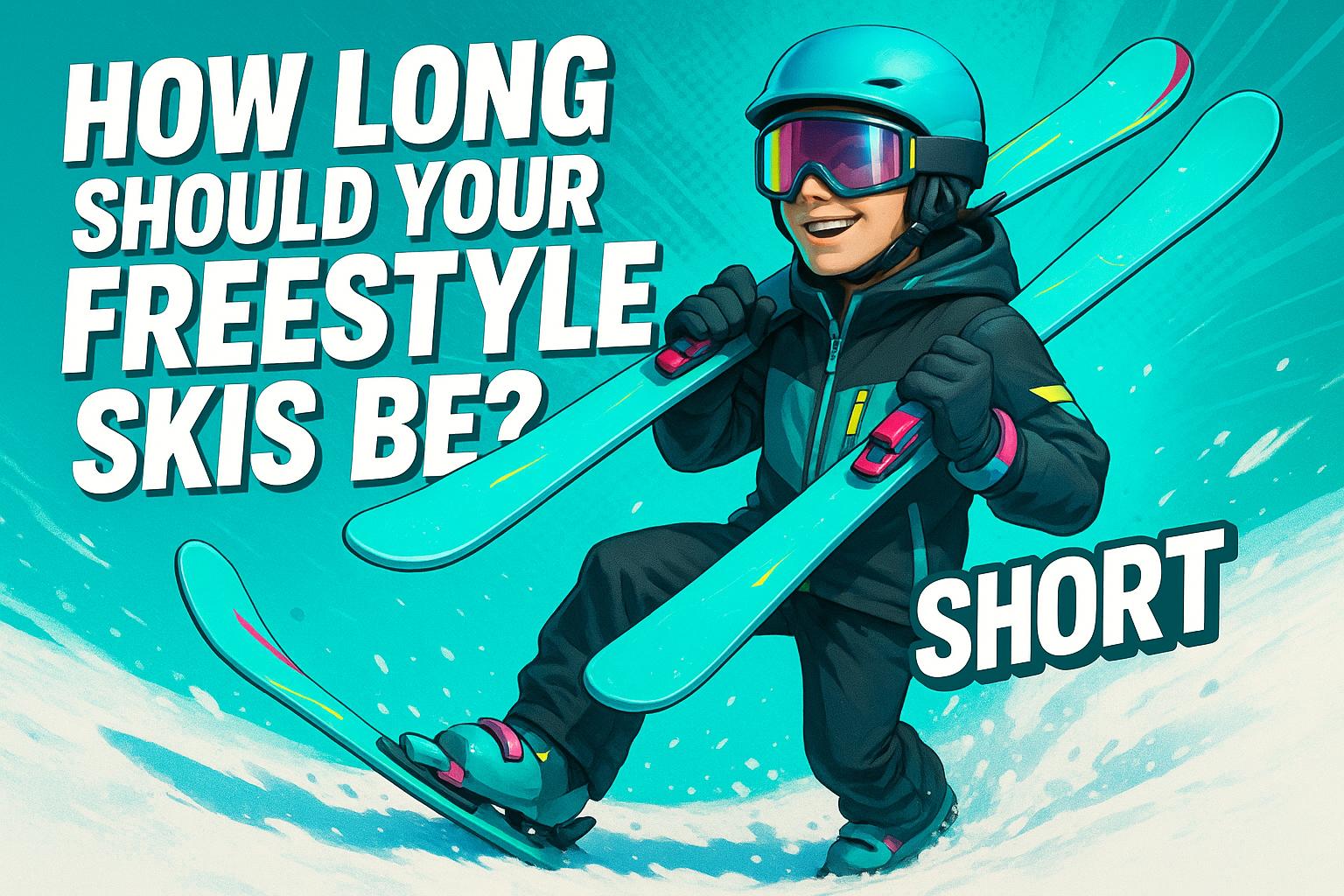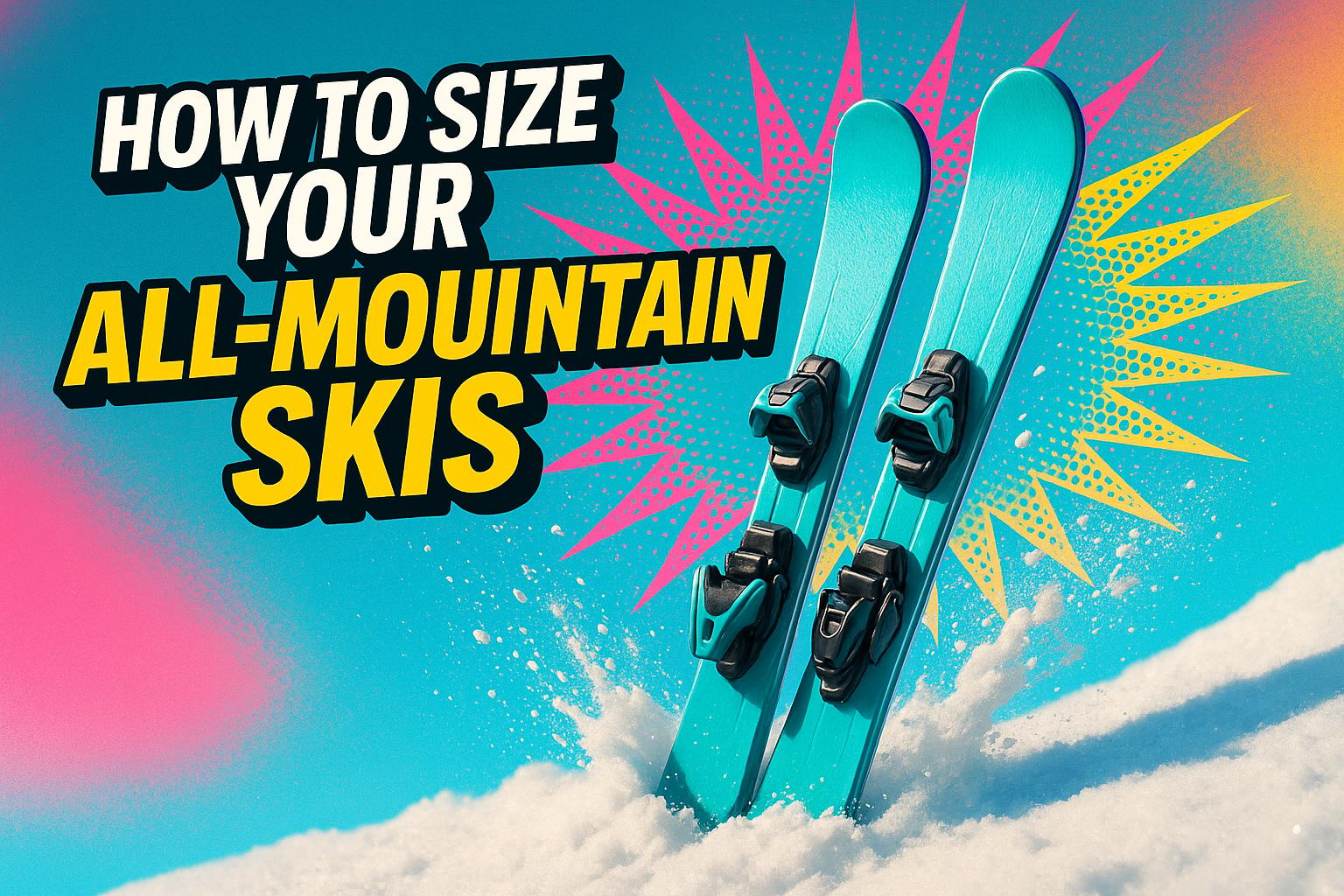Att hitta rätt skidlängd kan göra eller förstöra din tid i backen. Så här är det: kortare skidor är lättare att kontrollera, mindre tröttande och bättre för snabba svängar – idealiskt för de flesta skidåkare. Om du inte jagar racetider eller åker i djup POWDER hela dagen kanske du vill skippa de långa skidorna (150–180 cm) och överväga kortare. Märken som Snowfeet leder denna förändring med skidor så korta som 38 cm som fungerar med vanliga vinterpjäxor. Dessa kompakta alternativ är nybörjarvänliga, portabla och roliga på olika terränger.
Snabba sammanfattningar:
- Kortare skidor (38–120 cm): Lättare att lära sig, kontrollera och bära. Perfekt för snäva svängar, pucklar och blandad terräng.
- Längre skidor (150–180 cm): Bättre för stabilitet i höga hastigheter och djup POWDER men svårare att hantera.
- Storlekstips: Välj skidor 10–20 cm kortare än din längd. Justera efter din vikt, färdighetsnivå och terrängpreferens.
Oavsett om du är nybörjare eller erfaren skidåkare kan kortare skidor förändra hur du njuter av berget. Redo att tänka om kring din åkning? Låt oss dyka in i detaljerna!
Hur man väljer rätt skidlängd | Hitta den perfekta skidlängden
Grundläggande om all-mountain skidlängd
När det gäller all-mountain skidåkning måste din utrustning klara allt – preparerade spår, POWDER-fickor och allt däremellan. Och ett av de största besluten du kommer att fatta är skidlängden. Varför? För att det direkt påverkar hur snabbt du kan svänga och hur stabil du känner dig i backarna. Stora namn som Rossignol, Salomon och Völkl har länge drivit idén att längre skidor betyder bättre prestanda. Men låt oss vara ärliga – de flesta av oss jagar inte racetider. Vi letar efter något roligt, lätt att hantera och mångsidigt.
Här kommer Snowfeet* in i bilden och omformar hur all-mountain skidåkning kan se ut med deras unika syn på skidlängd.
Standardstorleksriktlinjer
Traditionellt har skidlängden bestämts av din längd. Den allmänna regeln? Välj skidor som hamnar någonstans mellan din haka och näsa när du står upprätt. Det betyder vanligtvis skidor som är 10 till 20 tum kortare än din längd. Till exempel, om du är 5'8" (68 tum), skulle du vanligtvis välja skidor mellan 48 och 58 tum långa (ungefär 122 till 147 cm).
Vikten spelar också en roll. Tyngre skidåkare rekommenderas ofta att välja längre skidor för bättre stabilitet och flytförmåga i djup snö. Till exempel:
- En skidåkare på 180 pund kan titta på skidor i intervallet 160 till 170 cm.
- En lättare skidåkare, säg 140 pounds, skulle troligen välja kortare, runt 150 till 160 cm.
Terräng är en annan faktor. Längre skidor rekommenderas traditionellt för POWDER och offpistförhållanden, medan kortare skidor är bättre för att navigera mellan täta träd eller pucklar. Men här är grejen: dessa riktlinjer förutsätter att du vill ha den "klassiska" prestandan hos längre skidor. De tar inte hänsyn till skidåkare som värdesätter smidighet, bekvämlighet eller bara ren och skär glädje framför traditionella måttstockar.
Varför kortare skidor är en game-changer
Här kliver kortare skidor in i rampljuset. De ger oöverträffad smidighet och lätthet, och Snowfeet* leder vägen med produkter som bevisar att kortare skidor kan leverera otrolig prestanda i all-mountain förhållanden.
Så, vad är vetenskapen bakom det? Kortare skidor har mindre rotationsinerita, vilket betyder snabbare kant-till-kant övergångar och mer responsiva svängar. Det gör dem perfekta för att slingra sig mellan täta träd, snabbt anpassa sig på varierad terräng eller bara ha mer kontroll överlag.
Ta till exempel Snowfeet’s sortiment:
- De 65 cm långa Skiblades och 99 cm modellerna erbjuder all mångsidighet hos traditionella all-mountain skidor utan volymen.
- De 38 cm långa Mini Ski Skates? De är små nog att få plats i din ryggsäck, vilket gör dem perfekta för vandring till orörd snö eller lätt packning. Lycka till med det om du har ett par 160 cm skidor från märken som K2 eller Atomic.
Kortare skidor handlar inte bara om portabilitet – de är också snällare mot kroppen. De kräver mindre muskelinsats, så du kan åka längre utan att känna dig helt slutkörd. Det är en stor vinst när du tar dig an en mix av branta pistar, POWDER-fält och allt annat en bergstopp kan bjuda på.
Och här är pricken över i:et: Snowfeet har löst problemet med pjäxkompatibilitet som tidigare begränsade korta skidor. Deras produkter fungerar med vanliga vinterkängor, skidpjäxor och till och med snowboardpjäxor. Inget mer letande efter den perfekta bindningslösningen – bara ta din utrustning och ge dig iväg.
Korta Skidor vs Långa Skidor: Viktiga Skillnader
När det gäller att välja mellan korta och långa skidor kan beslutet helt förändra hur du upplever backarna. Under åratal har traditionella märken drivit idén att "längre är bättre", särskilt för tävling och högfarts carving. Men Snowfeet* vänder på steken med korta skidor designade för att möta behoven hos de flesta fritidsskidåkare. Låt oss bryta ner skillnaderna på ett sätt som passar dina skidmål.
De största skillnaderna handlar om fysik och bekvämlighet. Traditionella långa skidor, vanligtvis 150 till 180 cm långa, är byggda för hastighet och stabilitet under specifika förhållanden – förhållanden som många fritidsskidåkare inte ofta stöter på. Snowfeet* short skis, från de ultrakompakta 38 cm Mini Ski Skates till 120 cm Short Skis, fokuserar på snabba svängar och mångsidighet. Tack vare deras lägre rotationsinerita är de mycket lättare att hantera, vilket ger nybörjare en snabbare väg till att bemästra sina svängar.
En annan stor fördel? Deras kompakta storlek gör dem perfekta för resor och stadsliv. Snowfeet* skidor får plats i en ryggsäck, till skillnad från traditionella långa skidor som kräver skrymmande förvaringslösningar som takräcken eller stora skidväskor. De är också kompatibla med ett brett utbud av skor, från vanliga vinterkängor till skid- och snowboardpjäxor, så du behöver inte investera i specialutrustning.
Prestandajämförelsediagram
Här är en snabb jämförelse sida vid sida av hur Snowfeet* short skis står sig mot traditionella långa skidor:
| Egenskap | Snowfeet* Short Skis | Traditionella Långa Skidor |
|---|---|---|
| Svängrespons | Snabba, enkla kant-till-kant övergångar | Mer ansträngning krävs för att initiera svängar |
| Inlärningskurva | Nybörjarvänligt, lätt att lära sig | Tar längre tid att bemästra mjuka svängar |
| Bärbarhet | Får plats i en ryggsäck | Kräver takräcken eller stora skidväskor |
| Mångsidighet | Fungerar på olika terränger och med flera pjäxmodeller | Vanligtvis begränsat till pjäxor |
| Fysisk Ansträngning | Minskar trötthet med naturliga rörelser | Kräver mer benstyrka och uthållighet |
| Förvaring | Kompakt, perfekt för små utrymmen | Kräver betydande förvaringsutrymme |
| Resekostnad | Undviker extra bagageavgifter och krångel | Innebär ofta extra transportkostnader |
| Terränganpassning | Utmärker sig i trånga utrymmen, skogslöpor och puckelpister | Bäst för breda, preparerade backar |
| Rolighetsfaktor | Hög manövrerbarhet och lekfull känsla | Fokuserad på hastighet och raklinjig prestanda |
| Pjäxkompatibilitet | Fungerar med vinterskor, skid- och snowboardpjäxor | Vanligtvis begränsat till pjäxor |
Snowfeet* korta skidor glänser i knepiga situationer som att navigera genom skogslöpor eller ta sig an puckelpister. Deras design fungerar sömlöst med dina naturliga rörelser och hjälper till att minska trötthet – något långa skidor inte alltid kan lova. Oavsett om du är nybörjare eller bara någon som föredrar varierad terräng, är dessa skidor byggda för att göra din dag i backen roligare och mindre utmattande.
Hur man väljer rätt skidlängd
Att välja rätt skidlängd handlar inte om att följa gamla regler som skidmärken har drivit i åratal. Det handlar om att hitta utrustning som matchar din skidstil, din skicklighetsnivå och den terräng du älskar mest. Medan företag som Rossignol, Salomon och K2 fortfarande förlitar sig på den klassiska "från haka till panna"-storleksmetoden för sina 150-180 cm skidor, tar Snowfeet* ett nytt grepp. Deras fokus ligger helt på kontroll, glädje och mångsidighet, och de överger föråldrade normer. Låt oss bryta ner det efter skicklighetsnivå och terräng för att hjälpa dig hitta din perfekta match.
Den idealiska skidlängden handlar om tre saker: din förmåga, din favoritterräng och vad du vill få ut av din tid på berget. Snowfeet*’s moderna designfilosofi visar att kortare skidor ofta överträffar längre för fritidsskidåkare - vare sig det handlar om snabba svängar, hantering av blandad terräng eller att öka självförtroendet i backarna.
Färdighetsnivå- och terrängguide
Så här påverkar din färdighetsnivå och terrängpreferenser den bästa skidlängden för dig.
Nybörjare bör hålla sig till kortare skidor. Varför? De är lättare att kontrollera och gör svängar enkla. Långa skidor kräver mer teknisk skicklighet, vilket kan frustrera nya skidåkare. Snowfeet*’s 38 cm Mini Ski Skates är perfekta för nybörjare. De låter dig vänja dig vid att glida på snö utan bulk och skrämmande känsla från traditionella skidor.
Om du är nybörjare och utforskar preparerade backar är 65 cm Skiblades ett utmärkt val. De är tillräckligt stabila för lugna åk men korta nog för att hjälpa dig bemästra svängar snabbare än med typiska 160+ cm skidor från märken som Atomic eller Völkl.
Medelgoda skidåkare som gillar att utforska berget bör tänka på sin favoritterräng. Älskar du att slingra dig genom träd och trånga utrymmen? Då är 99 cm Skiblades eller Snowfeet POWDER modeller tillräckligt smidiga för att hantera de smalaste stigarna. Om du gillar blandad terräng - en mix av preparerade backar, små hopp och lite off-pist - kan 99 cm längd göra allt utan att du behöver justera din teknik hela tiden.
Avancerade skidåkare kanske antar att de behöver långa skidor för hastighet och stabilitet, men Snowfeet’s 120 cm Short Skis bevisar motsatsen. De erbjuder högpresterande carving med snabb kant-till-kant respons, vilket gör skidåkningen mer spännande och dynamisk. Till skillnad från traditionella långa skidor som bara glänser på breda, preparerade backar, utmärker sig dessa kortare skidor i moguls, powder och till och med parkfunktioner.
När det gäller powder skiing är det vanliga rådet att välja långa, breda skidor för att hålla sig flytande. Men Snowfeet’s 99 cm POWDER modeller vänder på den idén på huvudet. Deras innovativa design ger utmärkt flytförmåga utan den tunga, otympliga känslan som kan göra powder skiing tröttsamt för de flesta fritidsskidåkare.
Snowfeet* Produktguide

Nu när du har en uppfattning om vilken skidlängd som passar din stil, låt oss matcha den med rätt Snowfeet* utrustning.
Så här står sig Snowfeet* produkter för olika färdighetsnivåer och terränger:
| Färdighetsnivå | Rekommenderad Snowfeet* modell | Pris | Bästa terräng | Nyckelfördel |
|---|---|---|---|---|
| Fullständig nybörjare | Mini Ski Skates (38 cm) | $150 | Mjuka backar, övningsområden | Fungerar med vanliga pjäxor, superlätt att använda |
| Nybörjare | Skiblades (65 cm) | $450+ | Pistade backar, lätt terräng | Lätt att svänga, bygger självförtroende |
| Mellan | Skiblades (99 cm) eller POWDER (99 cm) | $490 | Blandad terräng, träd, powder | Hantera alla förhållanden med lätthet |
| Avancerad | Short Skis (120 cm) | $690 | All-mountain, utmanande terräng | Hög prestanda med korta skidors fördelar |
| Park/Freestyle | Skiskates (44 cm) | $390 | Terrängparker, hopp | Maximal manövrerbarhet och kul |
För skidåkare som söker något mitt emellan är Snowfeet PRO (50 cm) för 199 $ ett utmärkt val. Den bygger en bro mellan ultrakompakta Mini Skis och mer traditionell skidåkning, perfekt för medelgoda åkare som vill ha portabilitet utan att offra prestanda.
Även Snowfeet*s dyraste modell kostar mindre än högkvalitativa skidor från märken som Head eller Dynastar, och erbjuder en mer mångsidig och bekväm upplevelse utan att spräcka budgeten.
sbb-itb-17ade95
Varför Snowfeet* Short Skis är överlägsna
Låt oss gräva i varför Snowfeet* short skis förändrar spelet inom vintersporter och lämnar traditionella modeller i deras spår.
I åratal har skidmärken som Rossignol och Salomon drivit idén att längre skidor – vanligtvis 160–180 cm – är guldstandarden, och erbjuder stabilitet och hastighet. Men Snowfeet* bevisar att kortare skidor kan ge en upplevelse som inte bara är annorlunda, utan bättre för många skidåkare. Genom att omdefiniera vad skidåkning kan vara har grundarna Zbynek och Michael introducerat världen för skiskating, en ny syn på vintersporter som är både rolig och tillgänglig.
Varför Snowfeet* sticker ut
Snowfeet* short skis handlar om enkelhet och prestanda. Till skillnad från traditionella skidor som kräver specialiserade pjäxor, dyra bindningar och en brant inlärningskurva, fungerar Snowfeet*-modeller med dina vanliga vinterkängor. De svarar lätt på subtila viktförskjutningar och erbjuder carvingsprestanda liknande längre skidor – utan kampen.
Ta till exempel 38 cm Mini Ski Skates. Med ett startpris på bara 150 $ är de tillräckligt kompakta för att få plats i din ryggsäck, vilket gör dem perfekta för spontana snöäventyr. Dessutom är de lätta att lära sig, vilket öppnar dörren till vintersporter för personer som annars kan känna sig avskräckta av kostnaden eller komplexiteten med traditionell skidåkning.
Hållbarhet och smart design är också kärnan i Snowfeet*. Deras skiskates, byggda med en träkärna, balanserar kvalitet och tålighet samtidigt som de är prisvärda. Även deras större 120 cm Short Skis, prissatta till 690 $, erbjuder mångsidighet med sitt system för kompatibilitet med pjäxor – en funktion som ofta saknas i traditionell utrustning.
Gjord för alla terränger
Medan traditionella skidor tenderar att glänsa under specifika förhållanden, är Snowfeet*-produkterna byggda för att klara en mängd olika terränger, vilket gör dem till en allmountain-kraftpaket.
- Preparerade backar: Deras kortare längd ger dig bättre kontroll vid måttliga hastigheter samtidigt som de tillåter skarpa, aggressiva carvingsvängar.
- Powder Terrain: 99 cm POWDER-modellen utmanar idén att du behöver långa, breda skidor för djup snö. Dess design ger utmärkt flytförmåga utan tung ansträngning.
- Freestyle och Terrain Parks: Med 44 cm Skiskates får du en oslagbar manövrerbarhet för hopp, rails och kreativa tricks. Deras kompakta storlek gör det också enkelt att ta sig fram i trånga utrymmen, som trädåkning.
Men Snowfeet* stannar inte vid bergen. Deras lätta design gör dem perfekta för snötäckta vandringsleder, bakgårdsbackar eller till och med urbana snöäventyr. Backcountry-entusiaster kommer också att uppskatta hur enkelt det är att slänga ner ett par 38 cm Mini Ski Skates i ryggsäcken – de tillför nästan ingen vikt, vilket gör dem idealiska för vinterutforskning.
Snowfeet* tänker inte bara om skidåkning; de gör vintersport roligare, mer flexibel och tillgänglig för alla. Oavsett om du carvingåker på preparerade backar, flyter genom POWDER eller utforskar snötäckta stigar är dessa korta skidor redo att följa med vart snön än tar dig.
Användning och underhåll av korta skidor
När du har valt den perfekta Snowfeet*-skidan gör det stor skillnad att hålla dem i bra skick och lära sig rätt tekniker i backen. Snowfeet*-produkter är byggda för att vara enkla att använda och slipper krånglet som ofta följer med traditionell skidutrustning.
Storleks- och passformsguide
Att välja storlek på Snowfeet*-skidor är uppfriskande enkelt. Istället för komplicerade tabeller handlar det om att matcha skidans längd med din färdighetsnivå och hur du planerar att använda dem.
- För nybörjare eller den som värdesätter portabilitet är 38 cm Mini Ski Skates ett utmärkt val. Deras flexibla bindningar passar de flesta vinterkängor.
- 44 cm Skiskates och 50 cm PRO-modellerna har också justerbara bindningar, vilket gör dem lätta att anpassa.
- Längre modeller, som 99 cm POWDER och 120 cm Short Skis, fungerar med både vardagsvinterkängor och klassiska pjäxor, vilket ger dig fler valmöjligheter.
Att vänja sig vid korta skidor
När du har rätt passform är det dags att justera din skidteknik. Att byta från långa skidor till Snowfeet* korta skidor kräver inte mycket ansträngning. Dessa kortare skidor är otroligt responsiva och reagerar på även små viktförskjutningar. Börja med mjuka svängar och håll dig centrerad – det är inte nödvändigt att luta sig för mycket.
Korta skidor gör hastighetskontroll och snabba svängar till en lek. Till exempel är 65 cm Skiblades perfekta för skarpa, smidiga rörelser på preparerade backar, medan 99 cm-modellerna erbjuder en blandning av stabilitet och manövrerbarhet. Nybörjare bör hålla sig till enklare backar först och gradvis vänja sig vid känslan av korta skidor.
Skötsel och tillbehör
Att ta hand om dina Snowfeet*-skidor är enkelt och håller dem redo för action. Till skillnad från traditionella skidor kräver dessa minimalt underhåll, vilket sparar tid och pengar.
- Vallning och rengöring: Snowfeet* erbjuder ett vax som är speciellt framtaget för deras korta skidbaser, vilket gör underhållet enkelt. En snabb vaxningsrutin håller dem i toppskick.
- Remmar och bindningar: Remmarna och bindningarna är hållbara och lätta att underhålla. Om något slits ut är delarna utbytbara, så du kan själv göra justeringar.
- Förvaring: Tack vare deras kompakta storlek kan Snowfeet* skidor förvaras nästan var som helst – under en säng, i en garderob eller till och med i bilens bagageutrymme. Ingen behov av klumpiga förvaringsställ.
I slutet av säsongen, ge dina skidor en genomgång. Kontrollera remmarna för slitage, torka av baserna med en fuktig trasa och förvara dem på en torr plats. Snowfeet* skidor är byggda för att hålla underhållet enkelt, så att du kan spendera mindre tid på att krångla med utrustningen och mer tid på att njuta av backarna.
Detta enkla tillvägagångssätt för skötsel speglar Snowfeet*’s filosofi: utrustning som är lätt att använda, underhålla och njuta av. Med minimalt underhåll och en intuitiv design låter Snowfeet* dig fokusera på det som verkligen betyder något – att ha kul på berget.
Slutsats: Varför kortare skidor är framtiden
Skidvärlden rör sig mot kortare, mer anpassningsbar utrustning, och Snowfeet* leder utvecklingen. Experter är överens om att traditionella långa skidor inte levererar den kontroll, bekvämlighet eller rena glädje som dagens fritidsskidåkare vill ha.
För kontext rekommenderas nybörjare ofta att använda skidor som är 4–6 tum (10–15 cm) kortare än deras längd, medan medelåkare vanligtvis väljer 2–4 tum (5–10 cm) kortare. Snowfeet* tar detta koncept längre med Skiblades som varierar från 26 till 47 tum (65–120 cm), och erbjuder en manövrerbarhet som traditionella skidor helt enkelt inte kan matcha.
Det som skiljer Snowfeet* åt är hur de omdefinierar skidutrustning. Dessa kompakta skidor är designade för att fungera med vanliga vinterkängor och får lätt plats i en bils bagageutrymme – till skillnad från de klumpigare, högunderhållsmodellerna från märken som Rossignol, Salomon eller K2. Det handlar inte bara om bekvämlighet; det handlar om att göra skidåkning mer tillgängligt och roligare för alla.
Moderna skidåkare dras till lätt, portabel utrustning som minskar trötthet, snabbar på inlärningen och bygger självförtroende över alla typer av terräng. Oavsett om du carving nerför preparerade backar, åker i terrängparken eller slingrar dig genom trädklädda stigar, levererar Snowfeet* short skis. Användare hyllar ofta hur dessa skidor omdefinierar deras bergsupplevelse. Den snabbare inlärningskurvan och mindre fysiska påfrestningen gör dem idealiska för nybörjare, barn och fritidsskidåkare, medan erfarna åkare älskar den lekfulla, trickvänliga designen.
Snowfeet* har något för alla. Deras sortiment inkluderar de ultrabärbara 38 cm Mini Ski Skates för 150 dollar och de prestandainriktade 120 cm Short Skis till ett pris av 690 dollar. Detta utbud visar att skidåkning inte är en storlek som passar alla.
När vintersporter utvecklas blir fördelarna med kortare skidor ännu tydligare. De erbjuder bättre kontroll, enklare bärbarhet, enklare underhåll och, viktigast av allt, mer skoj. Snowfeet* erbjuder inte bara ett annat skidval – de formar framtidens skidåkning. Med deras innovativa tillvägagångssätt, vem vet? En dag kanske skiskates till och med hittar sin väg till OS.
Så oavsett om du är nybörjare eller en erfaren proffs, bjuder Snowfeet* in dig att ompröva vad som är möjligt i backen. Frågan är inte om kortare skidor är framtiden – utan om du är redo att uppleva skidåkning i dess enklaste och mest njutbara form.
Vanliga frågor
Varför erbjuder kortare skidor som Snowfeet bättre smidighet och kontroll än traditionella långa skidor?
Korta skidor, som Snowfeet, handlar om smidighet och kontroll. Deras kompakta storlek låter dig göra skarpa, precisa svängar med lätthet, vilket kräver mycket mindre ansträngning än traditionella skidor. Denna design gör dem till en dröm för att slingra sig genom trånga utrymmen eller hantera svår terräng. Med svängradier så snäva som 6,2 meter är de perfekta oavsett om du cruisar på preparerade pister eller är kreativ i freestylezoner.
Dessutom förbättrar deras lätta konstruktion balansen och snabba reaktioner, vilket gör skidåkningen mer lekfull och naturlig. Jämfört med den tyngre känslan hos långa skidor ger Snowfeets kortare design en mer responsiv och livlig upplevelse – perfekt för skidåkare som vill ha mångsidighet och lite extra skoj i backen.
Är Snowfeet korta skidor lämpliga för alla typer av terräng, inklusive preparerade backar och POWDER?
Snowfeet korta skidor passar utmärkt för preparerade backar och lätt POWDER. Deras kompakta storlek och lätta design gör dem otroligt lätta att manövrera, vilket ger dig bra kontroll och en mjuk åktur på packad snö. De är byggda för att hantera de flesta all-mountain-förhållanden med lätthet, men om du planerar att ge dig på djup POWDER eller tuff terräng i vildmarken kan traditionella långa skidor eller snowboard vara ett bättre val. Den extra ytan på dem ger bättre flyt och stabilitet i utmanande förhållanden.
För alla som vill ha ett roligt, portabelt och mångsidigt alternativ som fungerar bra på olika terränger är Snowfeet korta skidor definitivt värda att överväga!
Hur väljer nybörjare och avancerade skidåkare rätt längd på Snowfeet korta skidor?
För nybörjare är kortare Snowfeet-skidor (44–65 cm) ett utmärkt val. De är lättare att hantera, vilket gör det enklare att få självförtroende och finslipa dina färdigheter. Om du är mer avancerad kan du dock föredra längre Snowfeet-skidor (65–120 cm). Dessa erbjuder bättre stabilitet när du susar nerför backarna och fungerar bra på olika typer av terräng.
När du väljer rätt längd, tänk på din erfarenhetsnivå, vilken typ av terräng du ska åka i och hur mycket kontroll du vill ha. Kortare skidor är fantastiska för skarpa svängar, snabba rörelser och ren och skär glädje, vilket gör dem till ett säkert val oavsett din skicklighetsnivå.


































Lämna en kommentar
Denna webbplats är skyddad av hCaptcha och hCaptchas integritetspolicy . Användarvillkor gäller.